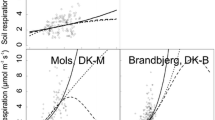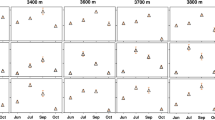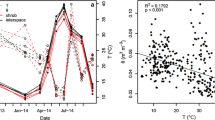Abstract
Soil respiration (R S) is known to be highly sensitive to different environmental factors, such as temperature, precipitation, and the soil carbon (C) pool. Thus, the scenario of global change expected for the coming decades might imply important consequences for R S dynamics. In addition, all of these factors may have an interactive effect, and the consequences are often confounded. We performed a field experiment to analyze the effect of soil moisture and habitat type on R S in a Mediterranean-type ecosystem by simulating three possible climate scenarios differing in the precipitation amount during summer (drier, wetter, and current precipitation pattern) in the main successional habitats in the area (forest, shrubland, and open habitat). We also considered other factors that would affect R S, such as the soil C pool and microbial biomass. By the use of structural-equation modeling (SEM), we disentangled the interactive effects of the different factors affecting R S. A higher simulated precipitation boosted R S for the different habitats across the sampling period (14.6% higher respect to control), whereas the more severe simulated drought reduced it (19.2% lower respect to control), a trend that was similar at the daily scale. Temperature had, by contrast, scant effects on R S. The SEM analysis revealed a positive effect of moisture and canopy cover on R S, whereas the effect of temperature was weaker and negative. Soil C pool and microbial biomass did not affect R S. We conclude that the precipitation changes expected for the coming decades would play a more important role in controlling R S than would other factors. Thus, the projected changes in the precipitation pattern may have much more profound direct effects on R S than will the projected temperature increases.





Similar content being viewed by others
References
Almagro M, López J, Querejeta JI, Martínez-Mena M. 2009. Temperature dependence of soil CO2 efflux is strongly modulated by seasonal patterns of moisture availability in a Mediterranean ecosystem. Soil Biol Biochem 41:594–605.
Arbuckle JL. 1994. AMOS: analysis of moment structures. Psychometrika 59:135–7.
Balogh J, Pintér K, Fóti S, Cserhalmi D, Papp M, Nagy Z. 2011. Dependence of soil respiration on soil moisture, clay content, soil organic matter, and CO2 uptake in dry grasslands. Soil Biol Biochem 43:1006–13.
Bauerle TL, Richards JH, Smart DR, Eissenstat DM. 2008. Importance of internal hydraulic redistribution for prolonging the lifespam of roots in dry soil. Plant Cell Environ 31:177–86.
Beniston M, Stephenson DB, Christensen OB, Ferro CAT, Frei C, Goyette S, Halsnaes K, Holt T, Jylhä K, Koffi B, Palutikof J, Schöll R, Semmler T, Woth K. 2007. Future extreme events in European climate: an exploration of regional climate model projections. Clim Change 81:71–95.
Bentler PM, Bonnet DG. 1980. Significance tests and goodness-of-fit in the analysis of covariance structures. Psychol Bull 88:588–606.
Bey A. 2003. Evapoclimatonomy modelling of four restoration stages following Krakatau’s 1883 destruction. Ecol Modell 169:327–37.
Browne MW. 1982. Covariance structures. In: Hawkins DM, Ed. Topics in applied multivariate analysis. Cambridge: Cambridge University Press. p 72–141.
Cable JM, Ogle K, Williams DG, Weltzin JF, Huxman TE. 2008. Soil texture drives responses of soil respiration to precipitation pulses in the Sonoran Desert: implications for climate change. Ecosystems 11:961–79.
Campbell JL, Sun OJ, Law BE. 2004. Supply-side controls on soil respiration among Oregon forests. Glob Change Biol 10:1857–69.
Casals P, Gimeno C, Carrara A, Lopez-Sangil L, Sanz MJ. 2009. Soil CO2 efflux and extractable organic carbon fractions under simulated precipitation events in a Mediterranean Dehesa. Soil Biol Biochem 41:1915–22.
Conant RT, Klopatek JM, Malin RC, Klopatek CC. 1998. Carbon pools and fluxes along an environmental gradient in northern Arizona. Biogechemistry 43:43–61.
Curiel-Yuste J, Janssens IA, Carrara A, Ceulemans R. 2004. Annual Q10 of soil respiration reflects plant phenological patterns as well as temperature sensitivity. Glob Change Biol 10:161–9.
Davidson EA, Belk E, Boone RD. 1998. Soil water content and temperature as independent or confounded factors controlling soil respiration in a temperate mixed hardwood forest. Glob Change Biol 4:217–27.
Davidson EA, Janssens IA. 2006. Temperature sensitivity of soil carbon decomposition and feedbacks to climate change. Nature 440:165–73.
de Dato GD, De Angelis P, Sirca C, Beier C. 2010. Impact of drought and increasing temperatures on soil CO2 emissions in a Mediterranean shrubland (gariga). Plant Soil 327:153–66.
Emanuel WR, Shugart HH, Stevenson MP. 1985. Climatic-change and the broad-scale distribution of terrestrial ecosystem complexes. Clim Change 7:29–43.
Euskirchen ES, Chen JQ, Gustafson EJ, Ma SY. 2003. Soil respiration at dominant patch types within a managed northern Wisconsin landscape. Ecosystems 6:595–607.
Giardina CP, Ryan MG. 2000. Evidence that decomposition rates of organic carbon in mineral soil do not vary with temperature. Nature 404:858–61.
Gough CM, Seiler JR. 2004. The influence of environmental, soil carbon, root, and stand characteristics on soil CO2 efflux in loblolly pine (Pinus tadea L.) plantations located on the South Carolina Coastal Plain. For Ecol Manag 191:353–63.
Hanson PJ, Edwards NT, Garten CT, Andrews JA. 2000. Separating root and soil microbial contributions to soil respiration: a review of methods and estimations. Biogeochemistry 48:115–46.
Harper CW, Blair JM, Fray PA, Knap AK, Carlisle JD. 2005. Increased rainfall variability and reduced rainfall amount decrease soil CO2 flux in a grassland ecosystem. Glob Change Biol 11:322–34.
Hayduck LA. 1987. Structural equation modelling with LISREL: essential and advances. Baltimore: John Hopkins University Press.
Hibbard KA, Law BE, Reichstein M. 2005. An analysis of soil respiration across northern hemisphere temperate ecosystems. Biogeochemistry 73:29–70.
Högberg P, Nordgren A, Buchmann N, Taylor AFS, Ekblad A, Högberg MN, Nyberg G, Ottosson-Löfvenius M, Read DJ. 2001. Large-scale forest girdling shows that current photosynthesis drives soil respiration. Nature 411:789–92.
Inglima I, Alberti G, Bertolini T, Vaccari FP, Gioli B, Miglietta F, Cotrufo MF, Peressotti A. 2009. Precipitation pulses enhance respiration of Mediterranean ecosystems: the balance between organic and inorganic components of increased soil CO2 efflux. Glob Change Biol 15:1289–301.
IPCC. 2007. Climate Change, 2007. The Physical Science Basis: Working Group I Contribution to the Fourth Assessment Report of the IPCC. Cambridge: Cambridge University Press.
Iriondo JM, Albert MJ, Escudero A. 2003. Structural equation modelling: an alternative for assessing causal relationships in threatened plant populations. Biol Conserv 113:367–77.
Janssens IA, Lankreijer H, Matteucci G, Kowalski AS, Buchmann N, Epron D, Pilegaard K, Kutsch W, Longdoz B, Grünwald T, Montagnani L, Dore S, Rebmann C, Moors EJ, Grelle A, Rannik Ü, Morgenstern K, Oltchev S, Clement R, Guomundsson J, Minerbi S, Berbigier P, Ibrom A, Moncrieff J, Aubinet M, Bernhofer C, Jensen NO, Vesala T, Granier A, Schulze ED, Lindroth A, Dolman AJ, Jarvis PG, Ceulemans R, Valentini R. 2001. Productivity overshadows temperature in determining soil and ecosystem respiration across European forests. Glob Change Biol 7:269–78.
Jenkinson DS, Powlson DS. 1976. Effects of biocidal treatments on metabolism in soil. 5. Method for measuring soil biomass. Soil Biol Biochem 8:209–13.
Kosmas C, Danalatos NG, López-Bermúdez F, Romero-Díaz MA. 2002. The effect of land use on soil erosion and land degradation under Mediterranean conditions. In: Geeson NA, Brandt CJ, Thornes JB, Eds. Mediterranean desertification: a mosaic of processes and responses. Chichester: Wiley. p 57–70.
Lloyd J, Taylor JA. 1994. On the temperature-dependence of soil respiration. Funct Ecol 8:316–23.
Luo Y, Zhou X. 2006. Soil respiration and the environment. Oxford: Academic Press.
Marañón-Jiménez S, Castro J, Kowalski AS, Serrano-Ortiz P, Reverter BR, Sánchez-Cañete EP, Zamora R. 2011. Post-fire soil respiration in relation to burnt wood management in a Mediterranean mountain ecosystem. For Ecol Manag 261:1436–47.
Matías L, Mendoza I, Zamora R. 2009. Consistent pattern of habitat and species selection by post-dispersal seed predators in a Mediterranean mosaic landscape. Plant Ecol 203:137–47.
Matías L, Castro J, Zamora R. 2011. Soil-nutrient availability under a global-change scenario in a Mediterranean mountain ecosystem. Glob Change Biol 17:1646–57.
Moncrief JB, Fang C. 1999. A model for CO2 production and transport. 2: application to a Florida Pinus elliottii plantation. Agric For Meteorol 95:237–56.
Murphy M, Balser T, Buchmann N, Hahn V, Potvin C. 2008. Linking tree biodiversity to belowground process in a young tropical plantation: impacts on soil CO2 flux. For Ecol Manag 255:2577–88.
Phillips CL, Nickerson N, Risk D, Bond BJ. 2011. Interpreting diel hysteresis between soil respiration and temperature. Glob Change Biol 17:515–27.
Pyke CR, Andelman SJ. 2007. Land use and land cover tools for climate adaptation. Clim Change 80:239–51.
Querejeta JI, Egerton-Warburton LM, Allen MF. 2007. Hydraulic lift may buffer rhizosphere hyphae against the negative effects of severe soil drying in a California oak savanna. Soil Biol Biochem 39:409–17.
Raich JW, Schlesinger WH. 1992. The global carbon-dioxide flux in soil respiration and its relationship to vegetation and climate. Tellus Ser B 44:81–99.
Reichstein M, Tenhunen JD, Roupsard O, Ourcival JM, Rambal S, Dore S, Valentini R. 2002. Ecosystem respiration in two Mediterranean evergreen Holm Oak forests: drought effects and decomposition dynamics. Funct Ecol 16:27–39.
Reichstein M, Rey A, Freibauer A, Tenhunen J, Valentini R, Banza J, Casals P, Cheng Y, Grünzweig JM, Irvine J, Joffre R, Law BE, Loustau D, miglietta F, Oechel W, Ourcival JM, Pereira JS, Pressotti A, Ponti F, Qi Y, Rambal S, Rayment M, Romanya J, Rossi F, Tedeschi V, Tirone G, Xu M, Yakir D. 2003. Modeling temporal and large-scale spatial variability of soil respiration from soil water availability, temperature and vegetation productivity indices. Global Biogeochem Cycles 17:1–15.
Rey A, Pegoraro E, Tedeschi V, De Parri I, Jarvis PG, Valentini R. 2002. Annual variation in soil respiration and its components in a coppice oak forest in Central Italy. Glob Change Biol 8:851–66.
Rey A, Petsikos C, Jarvis PG, Grace J. 2005. Effect of temperature and moisture on rates of carbon mineralization in a Mediterranean oak forest soil under controlled field conditions. Eur J Soil Sci 56:589–99.
Rodrigo FS. 2002. Changes in climate variability and seasonal rainfall extremes: a case study from San Fernando (Spain), 1821–2000. Theor Appl Climatol 72:193–207.
Saito M, Kato T, Tang Y. 2009. Temperature controls ecosystem CO2 exchange of an alpine meadow on the northeastern Tibetan Plateau. Glob Change Biol 15:221–8.
Schimel DS. 1995. Terrestrial ecosystems and the carbon cycle. Glob Change Biol 1:77–91.
Shen W, Jenerette GD, Hui D, Phillips RP, Ren H. 2008. Effects of changing precipitation regimes on dryland soil respiration and C pool dynamics at rainfall event, seasonal and interannual scales. J Geophys Res 113:G03024.
Shen W, Reynolds JF, Hui D. 2009. Responses of dryland soil respiration and soil carbon pool size to abrupt vs. combined changes in soil temperature, precipitation, and atmospheric [CO2]: a simulation analysis. Glob Change Biol 15:2274–94.
Shipley B. 2000. Cause and correlation in biology: a user’s guide to path analysis, structural equations, and causal inference. Cambridge: Cambridge University Press.
Sparks DL. 1996. Methods of soil analysis. Part 3. Chemical methods. Madison (WI): Soil Science Society of America and American Society of Agronomy.
Sponseller RA. 2007. Precipitation pulses and soil CO2 flux in a Sonoran Desert ecosystem. Glob Change Biol 13:426–36.
Talmon Y, Sternberg M, Grünzweig JM. 2011. Impact of rainfall manipulations and biotic controls on soil respiration in Mediterranean and desert ecosystems along an arid gradient. Glob Change Biol 17:1108–18.
Tanaka JS, Huba GJ. 1985. A fit index for covariance structure models under arbitrary GLS estimation. Brit J Math Stat Psychol 38:197–201.
Thomey ML, Collins SL, Vargas R, Johnson JE, Brown RF, Natvig DO, Friggens MT. 2011. Effect of precipitation variability on net primary production and soil respiration in a Chihuahuan Desert grassland. Glob Change Biol 17:1505–15.
Xu L, Baldocchi DD, Tang J. 2004. How soil moisture, rain pulses, and growth alter the response of ecosystem respiration to temperature. Global Biogeochem Cycles 18:GB4002.
Xu M, Qi Y. 2001. Soil-surface CO2 efflux and its spatial and temporal variations in a young ponderosa pine plantation in northern California. Glob Change Biol 7:667–77.
Yahdjian L, Sala OE. 2002. A rainout shelter design for intercepting different amounts of rainfall. Oecologia 133:95–101.
Zar JH. 1984. Biostatistical analysis. 2nd edn. London: Prentice-Hall.
Zheng D, Chen J, Noormets A, Le Moine J, Euskirchen E. 2005. Effects of climate and land use on landscape soil respiration in northern Wisconsin, 1972–2001. Clim Res 28:163–73.
Acknowledgments
We thank the Consejería de Medio Ambiente (Andalusian Government) and the Direction of the Sierra Nevada National Park for facilities and support to carry out the experiment. We also wish to thank to N. Villegas and L.M. Oviedo for field assistance during measurement campaigns and to S. Marañón and A. Kowalsky for their helpful comments. This study was supported by the coordinated Spanish MEC Project DINAMED (CGL2005-05830-C03), GESBOME (P06-RNM-1890), CONSOLIDER (CSD2008-00040), INIA Project SUM2006-00010-00-00, and by a grant FPI-MEC (BES-2006-13562) to LM. This research is part of the GLOBIMED (www.globimed.net) network in forest ecology.
Author information
Authors and Affiliations
Corresponding author
Additional information
Author Contributions
RZ, JC, and LM designed experiment; LM performed research and analyzed the data; LM, JC, and RZ wrote the article.
Electronic supplementary material
Below is the link to the electronic supplementary material.
Rights and permissions
About this article
Cite this article
Matías, L., Castro, J. & Zamora, R. Effect of Simulated Climate Change on Soil Respiration in a Mediterranean-Type Ecosystem: Rainfall and Habitat Type are More Important than Temperature or the Soil Carbon Pool. Ecosystems 15, 299–310 (2012). https://doi.org/10.1007/s10021-011-9509-8
Received:
Accepted:
Published:
Issue Date:
DOI: https://doi.org/10.1007/s10021-011-9509-8




